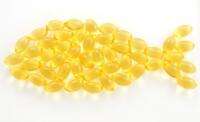Higher monthly doses of vitamin D associated with increased risk of falls

Higher monthly doses of vitamin D were associated with no benefit on low extremity function and with an increased risk of falls in patients 70 or older in a randomized clinical trial, according to an article published online by JAMA Internal Medicine.
Lower extremity function that is impaired is a major risk factor for falls, injuries and a loss of autonomy. Vitamin D supplementation has been proposed as a possible preventive strategy to delay functional decline. However, definitive data are lacking.
Heike A. Bischoff-Ferrari, M.D., Dr.P.H., of the University Hospital Zurich, Switzerland, and coauthors conducted a one-year, randomized clinical trial that include 200 men and women 70 or older with a prior fall.
Participants were divided into three study groups: 67 people in a low-dose control group who received 24,000 IU of vitamin D3 per month; 67 people who received 60,000 IU of vitamin D3 per month; and 66 people who received 24,000 IU of vitamin D3 plus calcifediol per month. The study measured improvement in lower extremity function, achieving 25-hydroxyvitamin D levels of at least 30 ng/mL at six and 12 months, and reported falls.
The authors report:
- Of the 200 participants, 58 percent were vitamin D deficient at baseline
- Doses of 60,000 IU and 24,000 IU plus calcifediol were more likely to result in 25-hydroxyvitamin D levels of at least 30 ng/mL but they were associated with no benefit on lower extremity function
- Of the 200 participants, 60.5 percent (121 of 200) fell during the 12-month treatment period
- The 60,000 IU and 24,000 IU plus calcifediol groups had higher percentages of participants who fell (66.9 percent and 66.1 percent, respectively) compared with the 24,000 IU group (47.9 percent)
- The 60,000 IU and 24,000 IU plus calcifediol groups had a higher average number of falls (1.47 and 1.24, respectively) compared with the 24,000 IU group (0.94)
"Compared with a monthly standard-of-care dose of 24,000 IU of vitamin D3, two monthly higher doses of vitamin D (60,000 IU and 24,000 IU plus calcifediol) conferred no benefit on the prevention of functional decline and increased falls in seniors 70 years and older with a prior fall event. Therefore, high monthly doses of vitamin D or a combination of calcifediol may not be warranted in seniors with a prior fall because of a potentially deleterious effect on falls. Future research is needed to confirm our findings for daily dosing regimens," the study concludes.
"The strategy of supplementation with vitamin D to achieve serum levels of at least 30 ng/mL has not been established by RCTs [randomized clinical trials] to reduce the risk of falls and fractures. It may increase the risk of falling. Until that approach is supported by randomized trials with updated meta-analyses, it would be prudent to follow recommendations from the Institute of Medicine (IOM) that people 70 years or older have a total daily intake of 800 IU of vitamin D without routine measurement of serum 25 (OH)D levels. It is prudent to get recommended intakes of vitamin D and other vitamins from a balanced diet with foods that naturally contain what is manufactured into supplements," writes Steven R. Cummings, M.D., of the California Pacific Medical Center Research Institute, San Francisco, and coauthors.
More information: JAMA Intern Med. Published online January 4, 2016. DOI: 10.1001/jamainternmed.2015.7148
JAMA Intern Med. Published online January 4, 2016. DOI: 10.1001/jamainternmed.2015.6994
















